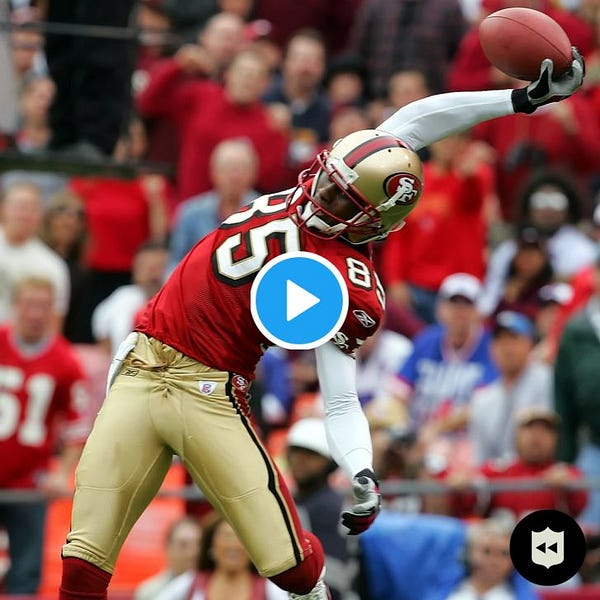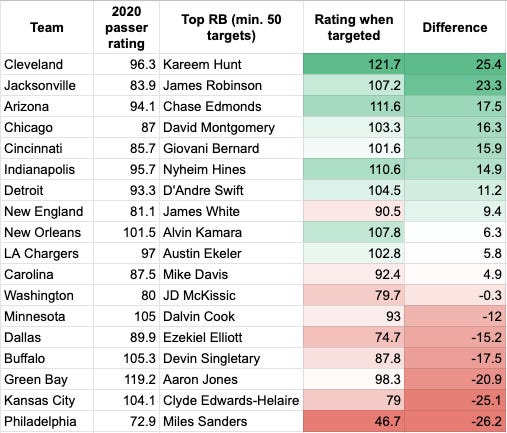Which NFL wideouts elevated their quarterbacks the highest?
Julio Jones is way up there. But so are ... Tyler Higbee and Laviska Shenault?
July 5 was Brandon Lloyd's birthday. I didn't have that on my calendar or anything. I learned it from one of those NFL highlight retweet factories on Twitter. And, for once, I was happy I fell for the clickbait and worked through the full three minute video that followed:
Lloyd was invaluable to the quarterbacks he shared a field with over a 11-year career. Passers ranging from journeymen to absolute legends knew that, under pressure, a pass that got 85 percent of the way to Brandon Lloyd had the opportunity to wind up on Sportscenter hours later. Though his career catch rate was only 48 percent, he made the catches he hauled in count.
This led to another logical question. Which receiver in the NFL provides the greatest value to his quarterback?
Fortunately, we've got some advanced data to back up the game tape and determine just who added the biggest boost in 2020. By comparing team passer ratings to a player’s individual rating when targeted, we can get a better idea of which QBs were blessed with great receiving corps and which suffered letdowns when hoping for a big play. This takes into account the wideouts and tight ends who were most reliable, as well as who helped pad their offenses’ passing stats with big run after catch numbers.
Here’s how that looks when we break down each NFL team by their top two WR/TE targets by passer rating, given a minimum of 50 targets last season:
(this has been re-uploaded because, for some reason, Substack hates it when you put two images next to each other and arbitrarily deletes one)
As with our running data breakdown, greener is better, redder is worse, and anything in regular white is right on average. The “difference” column is the split between a player’s passer rating when targeted and his team’s average passer rating for the 2020 season. As expected, teams with stacked receiving corps like the Buccaneers and Chiefs look great through this lens. Teams with less fruitful depth charts like the Patriots and Dolphins look bad.
There are some interesting cases as well. As good as the Cowboys’ WR chart has been, its most efficient wideouts may not be who you’d expect (Lamb and Gallup) and they haven’t significantly outplayed the QB play behind them. Aaron Rodgers may want more receiving help, but it turns out Robert Tonyan and Davante Adams are pretty damn valuable to begin with.
The Eagles’ underrated combination of Dallas Goedert and Travis Fulgham could play a major role in propping up Jalen Hurts next season. The Rams’ skill players should help boost Matthew Stafford to new heights after underwhelming returns from his WR/TE group last fall.
Here’s how that data looks if you sort by top performers rather than by team:
(again, this wasn’t included in the email version because Substack is a butt. this should make waaaaaay more sense now)
Any metric that has Tyler Higbee at the top and DeAndre Hopkins clocking in right around the average isn’t great, but it’s important to note this isn’t a reflection on how good a player is in general. Instead, it’s a look at the value he brought to his quarterback relative to the rest of the roster. Higbee was pivotal because he was a vital safety valve when Jared Goff lost the ability to make plays downfield. The Chargers top targets languished not because they weren’t good, but because Justin Herbert was so good at elevating guys further down the depth chart like Tyron Johnson and Donald Parham.
With a standard deviation of 14.3 passer rating points, 95 percent of all top WR/TE outcomes are expected to fall somewhere between a 134.8 and 77.6 rating when targeted. Anything higher is a major outlier. Anything lower is, hoooo boy, pretty grim. Only Robert Tonyan broke significantly out of that scale to the happy side with a 147.6 rating last fall, buoyed by a likely unsustainable 18.6 percent touchdown rate (targets/touchdowns). Davante Adams also crashed the 134.8 barrier last year, because playing with Rodgers is pretty nice.
Six guys clocked in with a passer rating differential two full standard deviations (+28.6) from the norm:
Tyler Higbee
Julio Jones
Laviska Shenault
Tim Patrick
Dallas Goedert
and Chris Godwin
Higbee, Shenault, Patrick, and Goedert were each islands in a sea of bad-to-mediocre quarterbacking. That makes what Jones and Godwin (and Tonyan, who just barely missed the cutoff) that much more impressive. They each took former MVP quarterbacks (Matt Ryan, Tom Brady, Aaron Rodgers) and pushed them to god-tier status last fall. However, it’s also important to note each had a very reliable teammate to share the load, whether that was Calvin Ridley (45th among 64 eligible WR/TEs, but also doing so with Jones on the shelf roughly half the season), Mike Evans (ninth), or Adams (25th).
What does this mean for 2021? The Jets upgraded by adding Corey Davis and the Titans upgraded despite losing Corey Davis. Cole Beasley is useful, but probably not bringing the kind of value to make his recent Jenny McCarthy-isms endearing. And the Patriots, sweet jesus, were smart to devote nine figures worth of contracts on wideouts and tight ends this offseason.
Also, and this didn’t come up in the chart but I have to bring it up because it absolutely blows my mind, but holy shit was Evan Engram bad last year. His 55.4 passer rating was truly a unicorn of awfulness that made him the opposite of Julio Jones. He dropped 11 passes and poor Daniel Jones was intercepted on six of the 109 targets he threw Engram’s way. And Engram was still a Pro Bowler, for some reason!
What about running backs?
Good question! Only 18 teams had backs reach the 50 target threshold last season, though that would have been different had players like Christian McCaffrey and Saquon Barkley played a full season. The lesson, as we learned when we looked at value added on the ground by last year’s running backs, is that James Robinson is awesome.
Comparing passer rating among running backs is slightly glitchier than it was with WR/TEs since these backs typically run shorter routes and score fewer touchdowns through the air -- two components that can easily boost a QB’s rating. Unlike with the wideouts, no one really comes close to escaping the two-standard deviation threshold (in this case, some 33.8 points higher than their QB’s regular season number) that would paint them as exceptional.
Still, we can see Kareem Hunt is a valued counterbalance to Nick Chubb’s run game and that the Buccaneers got even richer by adding Bernard to their already packed backfield. Chase Edmonds is ready for that RB1 role in Arizona and D’Andre Swift might be as well in Detroit. David Montgomery is more than just a run-first back and Miles Sanders' seven drops and two interceptions given up made him a net negative as a pass catcher.
On its own, this data can only tell us so much. It lets us know which players have had a greater statistical impact than others when it comes to helping their teams, but it leaves gray space by overvaluing touchdowns and allowing yards after catch to prop up targets who may not add much when it comes to stretching the field.
What happens if we take average route depth, drops, and catchable pass rate into account? I’m going to dig into that further next week and see if we can’t come up with a useful equation to figure out just how valuable the NFL’s top receivers and tight ends were for the quarterbacks tasked with slinging them the ball.
But for now, just know Ryan Tannehill’s gonna be real happy with his new wideout, and that Matthew Stafford has one hell of an insurance policy if he needs to dump it off to his tight end. -- CD











